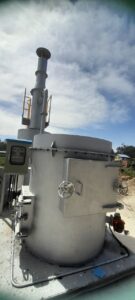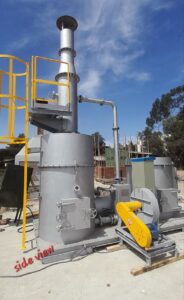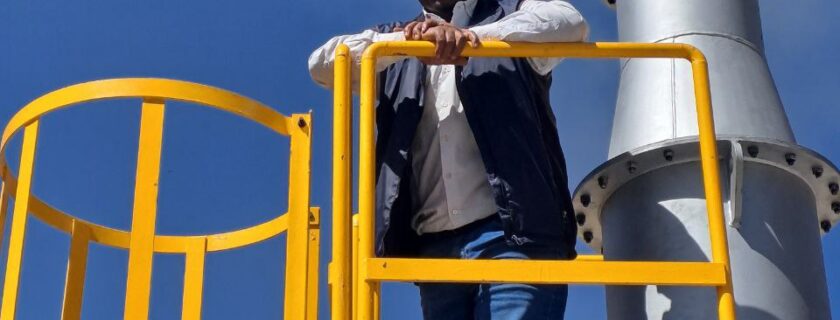A green and healthy hospital and research environment is one that promotes public health by continuously reducing its environmental impact and ultimately eliminating its contribution to the burden of disease. Cognizant of this, AHRI over the past two years has taken steps towards environmental action to ensure that it leads in the practice of primary prevention by actively engaging in efforts to foster community environmental health and health equity in its surrounding. To this end the Institute recently launched an environmental friendly biomedical waste incinerator within the research campus. For a comprehensive understanding of the project from “Conception to Installation”, the PR division reached out to Mr. Seid Mustefa, AHRI’s Environmental Health Researcher, for in-depth insights on the environmental cautious project. The following are excerpts from the candid interview;
How would you best describe the working mechanism of the biomedical waste incinerator?
Seid Mustefa: The biomedical waste incinerator is designed to feed and burn medical wastes in batches. It is structured in such a way to achieve smokeless, odourless and complete combustion through primary and secondary combustion chambers. Furthermore it is equipped with a nozzle, which is specially designed to generate partial dry distillation of gas which maximizes combustion efficiency.
What led to the conceptualization of this project?
Seid Mustefa: It is well known that inappropriate handling of infectious medical waste directly endangers human health and the environment. Infectious waste must be properly disposed of in practice.
Before this project, the only method of final waste disposal available at AHRI was burning in the open field and most recently in the Alert Hospital’s own brick incinerator. Thus due to this inadequate and poor incineration, there was always a potential harmful substances release to the environment.
Based on the environmental impact assessment proposal conducted previously (two years ago) in AHRI’s compound, the environmental unit under the safety case team of the Laboratory Management Division(LMD) suggested and requested for a biomedical waste incinerator. Following the request, the Institute embarked on the purchase process of a modern biomedical waste incinerator that conformed to the Federal Democratic Republic of Ethiopia’s environmental protection regulation as well as the environmental impact assessment done on the research institute’s environs.
How was this particular incinerator selected?
Seid Mustefa: We considered the following key points for selecting the intended biomedical waste incinerator based on some standards, such as:
- Determining our institution system for BMW (biomedical waste) treatment and disposal solution; i.e. Existing BMW-management infrastructure, Characterizing wastes, Quantity of wastes.
- Assessing the infrastructures in our institution (power source, land, roads availability)
- Determining the availability of resources in the institution (engineers for installation, management and maintenance);
- Assessing the national environmental policy (whether the Incinerator met the required standards, aligned with national guidelines) and the environmental impact assessment conducted by AHRI,
- Assessing the existing medical waste incinerators in similar Institutions/facilities (more than 5-areas/health facilities/institution) in Addis Ababa.
- Developing cost estimation;
- Identifying BMW incinerator design and determine for ordering/purchasing
- Following, the seven steps , the open tender process was carried out by the purchasing departments, after which the LMD went on to carry the necessary technical valuation, with the winner of the bid then taking on the contract.


How did AHRI go about installing the biomedical waste incinerator? Was there any special training of staff involved?
Seid Mustefa: The overall installation included site preparation, incinerator installation, service and operating instructions provision by the manufacturer and manufacturer’s agent support, metal works (fuel tank, filter and supply lines, electrical power supply etc.), and civil works (foundations, and water supply lines).
After conducting the necessary installation steps, the Institute finally had the latest Korean biomedical waste incinerator in its hands.
Training was indeed provided by the company/agents to service operators and engineers for smooth handling of day to day operations and long term maintenance of the incinerator. The comprehensive four day training included 3-engineers (from the engineering department), 3-maintenance personnel (from general service) and 1-environmental health professional (from the laboratory wing) and included provisional hands on course of service and operating instructions.
It is also worth mentioning that AHRI’s engineers and electricians were hands on in the process and played a vital role in the installation activities under minimal instruction and supervision of the Korean Company.
What is the waste reduction system like with this particular incinerator?
Seid Mustefa: Although the foundation and the floor of the incinerator house where the incinerator is installed has already been completed, the construction of the superstructure of the incinerator house along with the temporary waste-storage is under bidding process and hence the incinerator will be fully functional once the house construction is completed.
Accordingly, when the incinerator is fully operational, it will considerably decrease the amount of waste burned by reducing 100 kg of solid waste to 3-5 kg of ash which in turn significantly improves the impact of environmental pollution. Since the waste is incinerated at higher temperatures of up to 1200oC, pollution is zero to the environment.
Who stands to benefit from this project?
Seid Mustefa: The beneficiaries of the project are all staffs in the institution and ALERT hospital, clients/patients within the vicinity, and the community adjacent to the institution. Above all, since ambient air is not limited by boundaries, the medical waste incinerator has a significant contribution in purifying the emission of polluting gases into the atmosphere, so clean air is accessible to an unlimited community of beneficiaries.
Is there anything you would like to add?
Seid Mustefa: I would love to appreciate the all those who contributed to the successful realization of the incinerator progression. These includes the: LMD, Engineering department, General Service, Procurement department, Finance department and in general the higher level Management and administration and in particular Dr. Alemseged Abdissa, who played a vital role from the very beginning to the end of the project phase.
